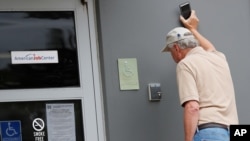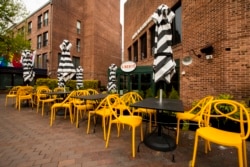The ranks of the unemployed keep growing in the U.S., with another 3.8 million workers claiming jobless compensation last week as the coronavirus pandemic continues to wreak havoc on the world’s biggest economy, the Labor Department reported Thursday.
The newest claims boosted the six-week total to 30.3 million, even as a few states have started to reopen some businesses and President Donald Trump is pushing to jump start the national economy.
But millions more workers could file for jobless assistance in the next few weeks as the full effect of the pandemic takes hold.
The United States has not seen this level of job losses – more than one out of every six workers -- since the Great Depression in the 1930s. The scope of the layoffs has wiped out the entirety of U.S. job growth since the 2008 recession.
The government reported Wednesday that the national economy declined 4.8% in the first quarter this year, with the prospect of a much bigger decline in the April-to-June quarter, more than at any point since World War II.
Credit Suisse is predicting a 33.5% decline, with investment banker Goldman Sachs slightly higher at 34% with a 15% unemployment rate.
However, Goldman is predicting a robust 19% gain in the third quarter from July through September as the U.S. moves toward a possible recovery from the pandemic.
Some companies laid off workers quickly in mid-March as the spread of the coronavirus became apparent. But other companies vowed to keep paying their workers, at least for a while, even as many of them had little work to do as their potential customers stayed home to protect themselves and their families.
Some companies have now laid off these workers as well, as the depth of the country’s economic turmoil takes hold.
The U.S. Congress has boosted the widely varying unemployment compensation paid by states by $600 a week for four months. States often make payments to laid-off workers that account for not quite half of what they were being paid.
But workers in states that are broadly reopening for business will face personal decisions whether they feel it is safe to return to work. Left open is the question whether they can continue to collect unemployment benefits if their state is allowing businesses to open but they personally have chosen not to return yet to their jobs.
The newest weekly total for jobless assistance claims is smaller than the last four weeks, when millions more applied for help. That possibly suggests that the downturn has stabilized to a degree.
But what is unknown is how long businesses will remain shut or operating only on a curtailed basis, leading to weeks of heightened layoffs. Millions of people could be out of work through the end of 2020.
At the moment, the reopening of the U.S. economy is a scattershot phenomenon, with governors in a handful of states telling shopkeepers, restaurants, hair and nail salons, bowling alleys and other commercial ventures they are free to reopen if they wish, while practicing social distancing and encouraging people to wear protective masks in public.
Executives of some of the country’s biggest corporations have warned Trump that more coronavirus testing needs to be done before workers return to their jobs.
Federal authorities recommended that Americans maintain at least a two-meter physical distance from other people through the end of April, but as the calendar turns to May Trump is ending the request.
The rapid pace of layoffs is unprecedented in recent U.S. history, although the extent of the economic damage is not precisely known. It took two years during the Great Recession in the two-year period between 2007 and 2009 for 8.6 million people to lose their jobs.
Numerous supporters of Trump have been pushing him to reopen the U.S. economy. Street protests have occurred over the last couple weeks, with demonstrators demanding that government officials call off the business shutdowns to let them go back to work.
But numerous stories are also appearing in U.S. media outlets of the deaths of people who voiced doubts they could fall victim to the coronavirus and instead ventured into public places and were fatally infected.










